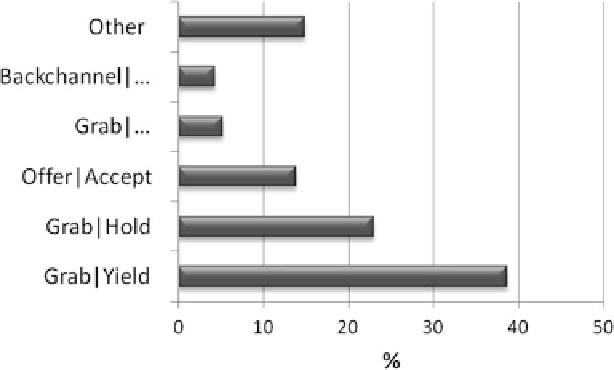Information Technology Reference
In-Depth Information
Fig. 20.5
Percentage of overlapping cases between turn management labels
annotations in the turn management layer. Annotations of turn management that do
not overlap are, in their majority, cases of turn initiation, greetings, and starting or
ending the discussion. In the latter cases, no overlapping speech is observed.
Most of the overlaps (67 %) occur with the
turn grab
label, which is meant to
indicate interruptions. Specifically,
turn grab
overlaps mostly with
turn yield
,fol-
lowed by
turn hold
, as well as with some other labels, as shown in Fig.
20.5
below.
It is attested that not all instances of simultaneous talk constitute interruptions; there
might also be collaborative or delayed completions, overlaps at transition relevant
places (c.f. the offer-accept pair of values), signaling feedback, or backchanneling.
However, the high frequency of the
turn grab
labels (paired with other labels) is
an indicator of pure interruptions that express the intention to claim the turn and
implies conflict between the goals and beliefs of the two speakers.
To better account for conflict cues emerging from the corpus, the turn-taking
structure was associated with the expressed emotions exploring the distribution of
emotionally annotated units overlapping with a turn management label at any point
in the units' lengths, i.e., either at the beginning, middle, or the end of a speech unit.
This was done by extracting from the annotated corpus speech segments attributed
both to a turn management and an emotion label. During a given interval, it was
often attested that an emotional unit overlapped with two turn management units,
when simultaneous speech occurs. For example, a negative emotion is expressed
by a speaker during simultaneous speech, where two turn management labels are
annotated, e.g.,
turn grab
by one speaker and
turn yield
by the other. In this case,
two overlaps are measured for the emotional unit perspective (one for grab and
one for yield, respectively) and one overlap from the turn management perspective.
The results show that 83 % of the emotionally labeled speech units overlap with
at least one (but also more than one) turn management label and 35 % of turn
management labels overlap with emotional labels because of the high number of

Search WWH ::

Custom Search